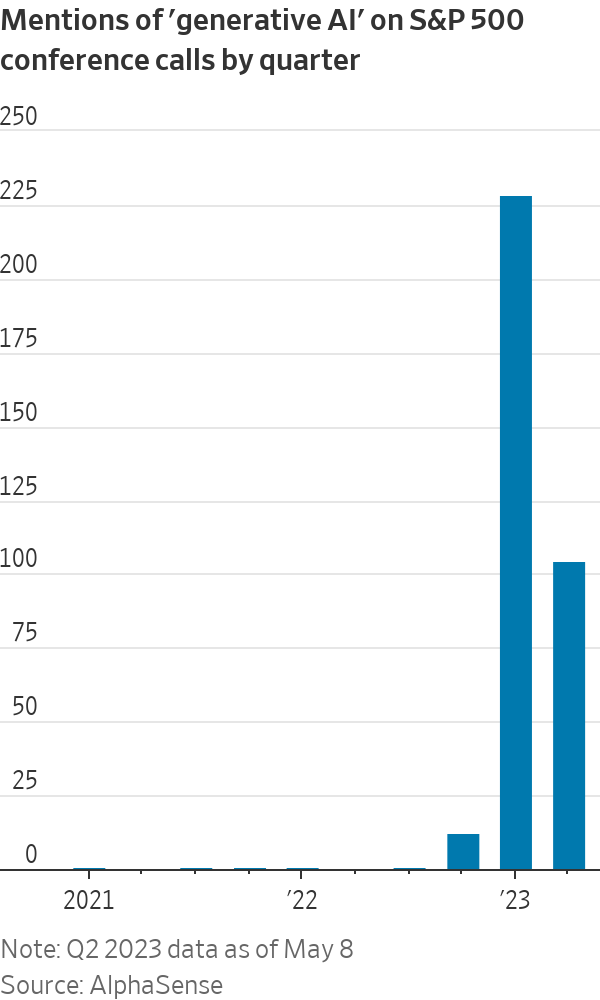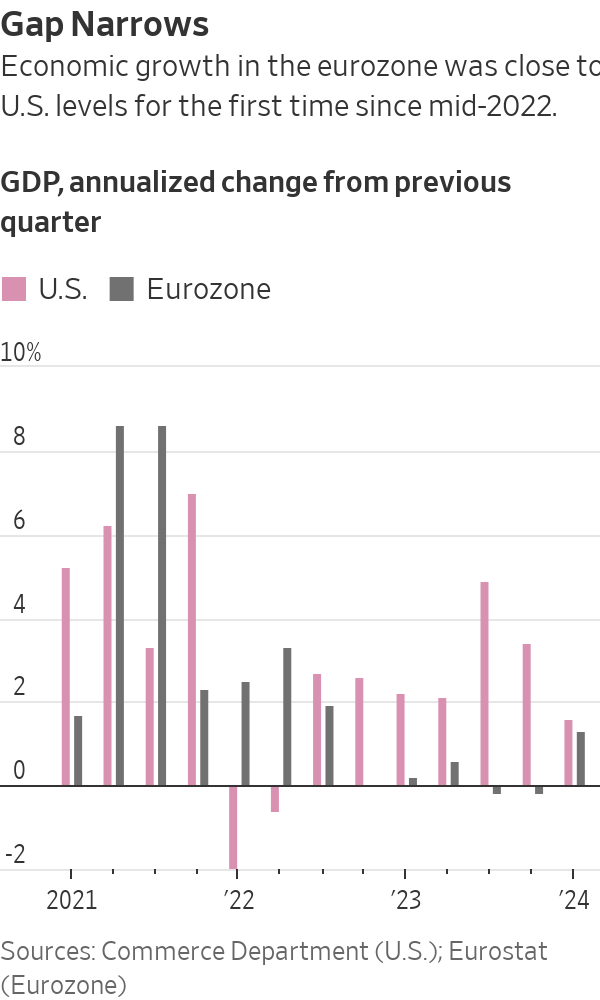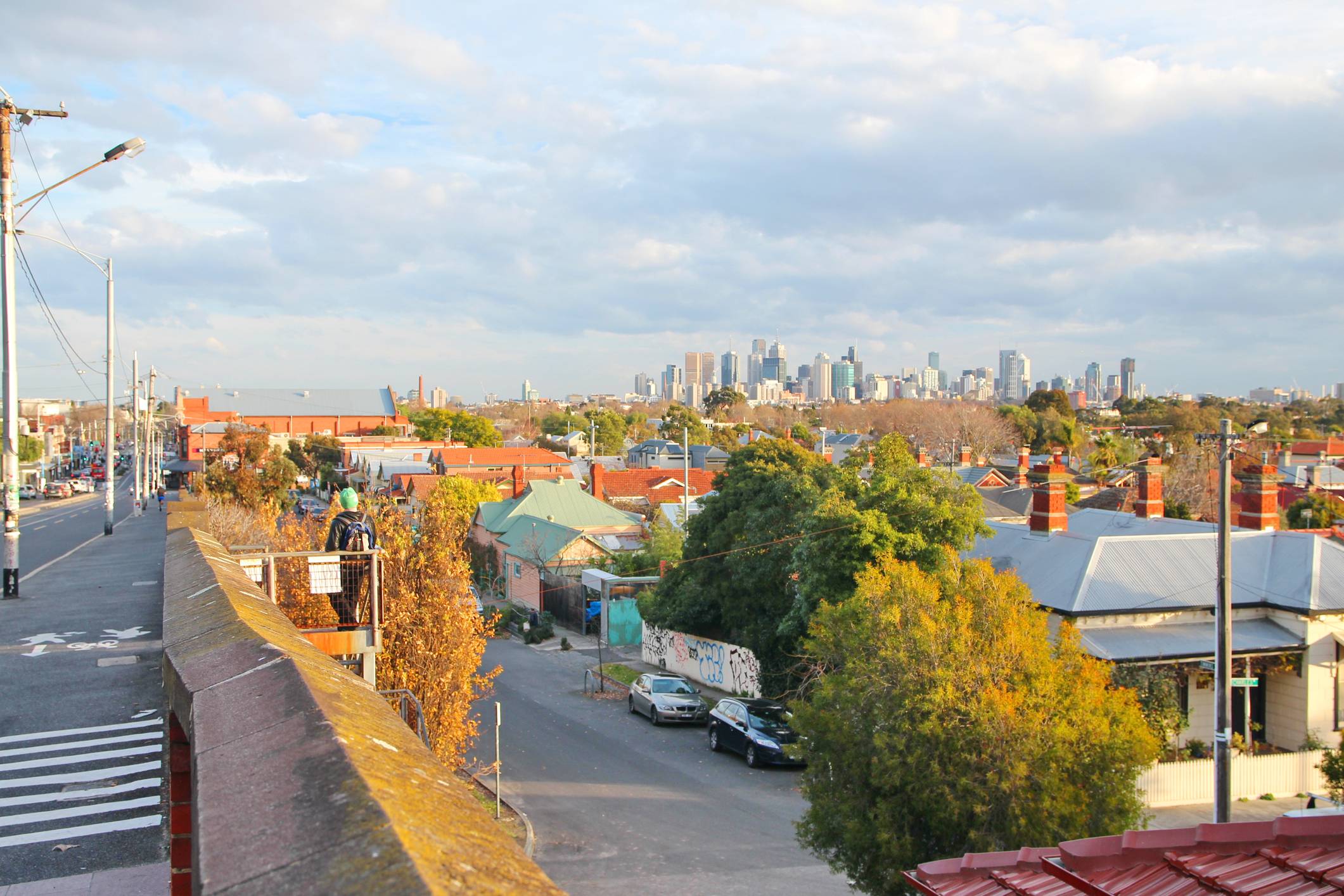ChatGPT Is Causing a Stock-Market Ruckus
Investors race to assess the rise of artificial intelligence as a possible ‘iPhone moment’
The rise of artificial intelligence is taking the tech world by storm. The technology is also making waves on Wall Street.
It is early days for so-called generative AI, a form of artificial intelligence that can conjure original ideas in the form of text, video or other media. But the tool has caused a stir in companies, schools, governments and the general public for its ability to process massive amounts of information and generate sophisticated content in response to prompts from users.
Big technology companies are investing billions of dollars in the technology. Startups are raising cash and trying to develop business models using AI at a rapid pace.

Investors are gauging the extent to which AI’s arrival will upend companies, industries and contemporary business practices—and placing bets accordingly. That has sent stocks swinging wildly in both directions: Chip maker Nvidia’s shares are surging, while shares of study-materials company Chegg have plummeted.Enthusiasm for the potential of AI is one reason big tech companies are among this year’s strongest performers.
There is little doubt that generative AI chatbots are popular. ChatGPT reached 100 million users in two months, the fastest app on record, analysts at Goldman Sachs said in a research note. In comparison, TikTok took nine months to reach that milestone, while Instagram took 30.
“We view AI as huge, and we’ll continue weaving it in our products on a very thoughtful basis,” Apple Chief Executive Tim Cook said last week on a conference call with analysts.
Apple isn’t alone. There have been more than 300 mentions of “generative AI” on company conference calls worldwide so far this year, according to data from AlphaSense. The phrase barely garnered a mention before 2023.
Major health systems are experimenting with AI to see whether the technology can help boost the productivity of their medical staffs. Entrepreneurs and venture-capital investors hope generative AI will revolutionise businesses from media production to customer service to grocery delivery. Even Coca-Cola told investors it is experimenting with the technology.
Some investors wonder whether generative AI is the latest tech with the potential to disrupt entire industries. The dawn of online streaming spelled the end of home-video-rental companies such as Blockbuster, while cameras on phones helped render photo processing obsolete and helped spark Apple’s rise and Kodak’s decline.

Artificial intelligence is “almost certainly overhyped in its initial implementation,” said Michael Green, chief strategist at Simplify Asset Management. “But the longer-term ramifications are probably greater than we can imagine.”
Microsoft has added nearly $500 billion in market value since the tech giant announced a $10 billion investment in startup OpenAI, developer of ChatGPT, in January. Shares of Nvidia, which makes chips needed to power the chatbots, have risen 96% so far this year. Google parent Alphabet shed $100 billion in market value in a single day earlier this year after its chatbot Bard underwhelmed investors, though those losses quickly reversed.
Alphabet shares are up 22% this year.
Those moves might prove ephemeral as the technology’s power becomes clearer, said Daniel Morgan, senior portfolio manager at Synovus Trust. “The most difficult thing to ascertain is, what is going to be the impact of all that spending to these companies on revenues and profits?” His fund owns shares of Microsoft, Alphabet and Nvidia.
The flurry of investor interest has pushed valuations higher. Nvidia trades at 164 times its past 12 months of earnings, according to FactSet. Microsoft and Alphabet trade at 33 times and 24 times, respectively.
Portfolio managers said the race to understand the implications of AI’s emergence is essential, both to invest in the technology’s winners and to avoid its eventual losers. Shares of Chegg fell 48% last week after the study-materials company said that the rise of ChatGPT was harming its ability to attract new customers.
“You just don’t know all the knock-on effects,” said Will Graves, chief investment officer at Boardman Bay Capital Management. “If this really is an iPhone moment, nobody saw that Uber was coming out of the iPhone to hammer the taxi industry.”
 Copyright 2020, Dow Jones & Company, Inc. All Rights Reserved Worldwide. LEARN MORE
Copyright 2020, Dow Jones & Company, Inc. All Rights Reserved Worldwide. LEARN MORE
This stylish family home combines a classic palette and finishes with a flexible floorplan
Just 55 minutes from Sydney, make this your creative getaway located in the majestic Hawkesbury region.
A sharp rebound in tourism in Europe’s sunbelt powers its economic rebound as core manufacturing centres struggle to recover
Europe’s economy has a north-south divide—and now it’s the poorer south that is powering the region’s return to growth.
Southern Europe, which for decades has had lower growth, productivity and wealth than the north, powered an upside-down recovery on the continent at the start of the year. Buoyant tourism revenue around the Mediterranean helped to offset sluggishness in Europe’s manufacturing heartlands.
The south’s transformation from laggard into growth engine reflects both a rapid rebound in visitor numbers from the collapse during the Covid-19 pandemic and a series of blows the continent’s large manufacturing sector has suffered, from surging energy prices to trade conflicts.
Now growth in the south is more than offsetting the north’s manufacturing malaise: As a whole, the eurozone economy grew at an annualised rate of 1.3% in the first quarter, ending nearly 18 months of economic stagnation in a sign that the currency area is recovering from the damage done by Russia’s invasion of Ukraine.
It was the eurozone’s strongest performance since the third quarter of 2022, and approached the U.S. economy’s 1.6% first-quarter growth rate, which was a slowdown from a racy pace of 3.4% at the end of last year.
In the 2010s, Germany helped to drag the continent out of its debt crisis thanks to strong exports of cars and capital goods. Between 2021 and 2023, Italy, Spain, Greece and Portugal contributed between a quarter and half of the European Union’s annual growth, according to a report last year by French credit insurer Coface —a trend now confirmed and amplified in the latest data.

In the first quarter, Spain was the fastest-growing of the big eurozone economies. It and Portugal recorded growth of 0.7% in the three months through the end of March from the previous quarter, while Italy’s economy grew by 0.3%. France and Germany both grew by 0.2%, the latter rebounding from a 0.5% quarter-on-quarter contraction at the end of last year.
This means Germany’s economy has grown by 0.3% in total since the end of 2019, compared with 8.7% for the U.S., 4.6% for Italy and 2.2% for France, according to UniCredit data.
In Spain, strong growth “seems to have been entirely due to strong tourism numbers,” said Jack Allen-Reynolds, an economist with Capital Economics. Tourism accounts for around 10% of the economies of Spain, Italy, Greece and Portugal.
The euro rose by about a quarter-cent against the dollar, to $1.0725, after the latest growth and inflation data were published.
The recovery comes as the European Central Bank signals it is preparing to reduce interest rates in June after a historic run of increases since mid-2022 that took it the key rate to 4%. Inflation in the eurozone remained at 2.4% in April, while underlying inflation cooled slightly, from 2.9% to 2.7%, according to separate data published Tuesday.
“The ECB hawks will point to the strong GDP number as [an] argument that ECB can take its rates lower gradually,” said Kamil Kovar, senior economist at Moody’s Analytics.
The eurozone economy has flatlined since late 2022 as Russia’s attack on its neighbor sent food and energy prices soaring in Europe and sapped business and household confidence. Gross domestic product fell in both the third and fourth quarters of last year, meeting a definition of recession widely used in Europe, but not in the U.S.
Southern Europe is one of only a handful of regions where international tourist arrivals returned to pre pandemic levels last year, according to United Nations data. Tourism revenue across the EU was one-quarter higher in the three months through the end of last June than in the same period in 2019, according to Coface data.
The recovery in international tourism was “notably driven by the arrival of many Americans who…were able to take advantage of favorable exchange rates,” Coface analysts wrote. “On the other hand, the end of the zero-Covid policy in China has initiated a gradual return of Chinese tourists, although remaining below 2019 levels.”
In Portugal, the number of foreign tourists hit a record of more than 18 million last year, up 11% compared with the prepandemic year of 2019, official data showed in January. American tourists in particular have returned to Europe in force.
Tourist numbers in Asia Pacific and the Americas continued to lag 2019 levels by 35% and 10% last year, respectively, the data show.
It is unclear how much further the tourism boom can run, but economists expect the region’s economic recovery to strengthen later this year as cooling inflation boosts household spending power and lower energy costs aid factory output.
Recent surveys point to an improved outlook for growth. Consumer confidence has risen to its highest level in two years, and a leading business-sentiment index has shown steady improvement from the start of 2024.
“We think that the combination of a robust labor market, comparatively strong wage hikes and lower inflation compared with last year will finally lead to a moderate recovery in consumer spending in the next few quarters,” said Andreas Rees , an economist with UniCredit in Frankfurt.
Just 55 minutes from Sydney, make this your creative getaway located in the majestic Hawkesbury region.
This stylish family home combines a classic palette and finishes with a flexible floorplan






















